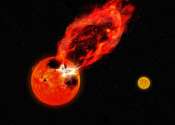Two low-mass stars and one brown dwarf discovered around aged stars
Using the Transiting Exoplanet Survey Satellite (TESS), an international team of astronomers has detected three companions to aged stars—two low-mass stars and one brown dwarf. The newfound objects are the size of Jupiter ...








